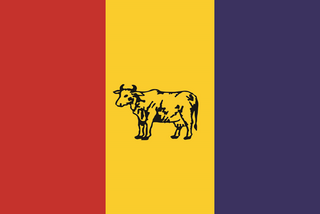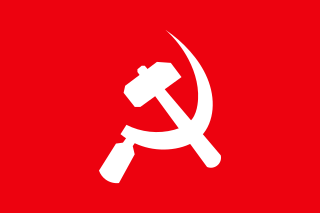
The politics of Nepal function within a framework of a republic with a multi-party system. Currently, the position of President of Nepal is occupied by Bidhya Devi Bhandari. The position of Prime Minister is held by Khadga Prasad Oli. Executive power is exercised by the Prime Minister and his cabinet, while legislative power is vested in the Parliament.

Birendra Bir Bikram Shah was the King of Nepal from 1972 until 2001. The eldest son of King Mahendra, he reigned until his death in the 2001 Nepalese royal massacre.

The Nepali Congress is a social-democratic political party in Nepal. It is the largest opposition party in the House of Representatives and the National Assembly.

Pushpa Kamal Dahal, commonly known as Prachanda, is a Nepalese politician, co-chair of the Nepal Communist Party and twice Prime Minister of Nepal, from 2008 to 2009 and from 2016 to 2017.

Baburam Bhattarai (Nepali: बाबुराम भट्टराई is a Nepalese politician who was Prime Minister of Nepal from August 2011 to March 2013. He was a long-time leading member of the Unified Communist Party of Nepal prior to founding a new party, Naya Shakti.

The Communist Party of Nepal was a communist political party in Nepal.

The Communist Party of Nepal was one of the two major communist parties in Nepal. The party was formed in January 1991 with the unification of the Communist Party of Nepal (Marxist) and the Communist Party of Nepal (Marxist–Leninist). It has led four governments: from 1994 to 1995 under Man Mohan Adhikari, from 2009 to 2011 under Madhav Kumar Nepal, in 2011 under Jhala Nath Khanal, and from 2015 to 2016 under KP Sharma Oli. The party was also a junior partner in five coalition governments: in 1997 under Lokendra Bahadur Chand, from 1998 to 1999 under Girija Prasad Koirala, from 2008 to 2009 under Pushpa Kamal Dahal, from 2011 to 2013 under Baburam Bhattarai, and from 2014 to 2015 under Sushil Koirala. It dissolved on 17 May 2018 to make way for the Nepal Communist Party in a merger with the Communist Party of Nepal.

Nepal Ratna Girija Prasad Koirala, affectionately known as Girija Babu, also known as G.P. Koirala, was a Nepalese politician. He headed the Nepali Congress and served as the Prime Minister of Nepal on four occasions, including from 1991 to 1994, 1998 to 1999, 2000 to 2001, and from 2006 to 2008. He was the Acting Head of State of Nepal between January 2007 and July 2008 as the country transitioned from a monarchy to a republic.

The Rastriya Prajatantra Party is a royalist political party in Nepal. It was formed by former Prime Ministers, Surya Bahadur Thapa and Lokendra Bahadur Chand. The party has had two Prime Ministers, Thapa and Chand, serving two terms each since the end of the Rastriya Panchayat.
The Nepal Workers and Peasants Party (NWPP) or Nepal Majdoor Kisan Party is a political party in Nepal. The party was founded on 23 January 1975 by Narayan Man Bijukchhe. The party enjoys most of its support from Bhaktapur.

Marxism–Leninism–Maoism–Prachanda Path refers to the ideological line of the Unified Communist Party of Nepal (Maoist), also known as the UCPN(M). It is considered a development of Marxism–Leninism–Maoism (MLM) and named after the leader of the UCPN(M), Pushpa Kamal Dahal, commonly known as Prachanda. Prachanda Path was proclaimed in 2001. The ideology was partially inspired by the example of the Communist Party of Peru, which refers to its ideological line as "Marxism–Leninism–Maoism–Gonzalo Thought".
The 1990 People's Movement was a multiparty movement in Nepal that brought an end to absolute monarchy and the beginning of constitutional democracy. It also eliminated the Panchayat system.
The term Madheshi people is ambiguous. Anthropologists use the term for people of Indian ancestry residing in the Terai of Nepal and comprising various cultural groups such as Hindu caste groups, muslims, merchants and indigenous people of the Terai. In recent times, some politicians and journalists use the term for all Nepali citizens of the Terai.

The Nepal Communist Party is the ruling political party in Nepal and is the largest communist party in South Asia and the third largest in Asia. It was founded on 17 May 2018, from the unification of two leftist parties, Communist Party of Nepal and Communist Party of Nepal. The unification was completed by the Party Unification Coordination Committee, after 8 months of planning. The two predecessor parties subsequently dissolved, making way for the new united party. The party retains the electoral symbol of the CPN, the sun. The party is the largest political party in the House of Representatives, National Assembly and in all but one of the seven provincial assemblies. KP Sharma Oli, the Prime Minister of Nepal since 15 February 2018, is co-chairman of the party along with Pushpa Kamal Dahal.
Hariyali Nepal Party is a political party in Nepal. The party is registered with the Election Commission of Nepal ahead of the 2008 Constituent Assembly election. It was established in 1997 and is a member of the Global Greens and the Asia-Pacific Green Network.
Rastriya Janamorcha is a communist political party in Nepal. It was originally founded in 1995 as the legal front of Communist Party of Nepal (Masal). It was refounded again in 2006 after breaking away from Janamorcha Nepal and has acted as the legal front for the Mohan Bikram Singh led Communist Party of Nepal (Masal).

Khadga Prasad Sharma Oli, more commonly known as KP Sharma Oli, is a Nepalese politician and the current Prime Minister of Nepal. He is the Co-chairman of the Nepal Communist Party (NCP) alongside Pushpa Kamal Dahal. Oli previously served as prime minister from 11 October 2015 to 3 August 2016 and was the first elected prime minister under the newly adopted Constitution of Nepal.

The Provinces of Nepal were formed on 20 September 2015 in accordance with Schedule 4 of the Constitution of Nepal. The seven provinces were formed by grouping the existing districts. The current system of seven provinces replaced an earlier system where Nepal was divided into 14 Administrative Zones which were grouped into five Development Regions.
Communism in Nepal traces its roots back to the pro-democracy movement of 1951, and the subsequent overthrow of the autocratic Rana regime and the establishment of democracy in Nepal. The communist movement in Nepal has split into factions multiple times and multiple factions have come together into a single fold at times as well. It has a history of getting banned from open political discourse; as well as multiple instances of embracing guerrilla insurgency, most notably, the Maoist insurgency in the 1990s and early 2000s that led to the Nepalese civil war, claiming at least 15,000 lives. After the Maoists and other main political parties formed a united coalition, launching a successful peaceful civil resistance against the dictatorial coup d'etat by the monarchy, which resulted in the abolition of monarchy and drafting of a new constitution affirming Nepal as a secular, federal, democratic republic striving towards democratic socialism, the two main communist parties of Nepal contested the first election according to the new constitution as a coalition, eventually leading to the unification of two parties with a strong majority in the federal parliament as well as six out of seven provinces of Nepal.












